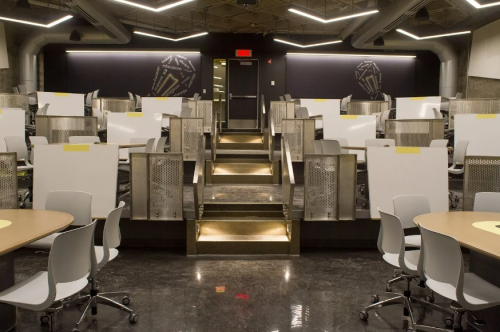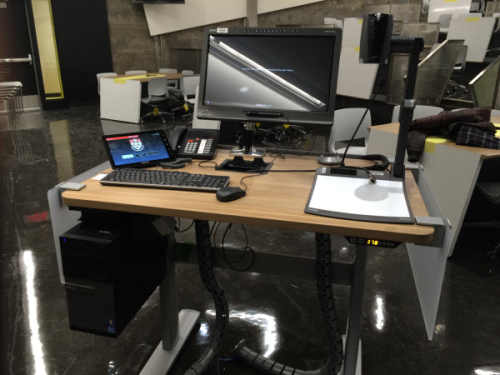- Location: 3700 McTavish Street, Montreal, QC
- Capacity: 96 students
- Type: Tiered Classroom
Alignment with principles for designing Teaching and Learning Spaces
Academic challenge
Promote individual, active engagement with content.
Layout
Substantial work surfaces for notebooks, laptops, and textbooks.
Furniture
Comfortable, adjustable-height chairs on wheels permit students to work individually or in groups at their tables.
Technologies
Access to resources: table-top power plugs for student laptops, LMS, internet (via student laptops). Multiple sources and screens for simultaneous display of different learning materials. Lecture recording permits individual review of courses materials after attending class.
Lighting & colour
Appropriate lighting for individual work. Yellow accents on tabletops and other surfaces brighten the room.

Learning with peers
Promote active engagement with one another.
Layout
Promotes face-to-face communication with a unique small group table design on each tier. Students can move about classroom with ease due to centre aisle. Unobstructed sightlines.
Acoustics: Sound zones support multiple simultaneous conversations among students. Appropriate amplification is available, with a push-button microphone for students at each table.
Furniture
Chairs on wheels permit students to turn and discuss with those nearby, supporting a variety of collaborative learning approaches. Rounded tables allow students to work together collaboratively in small groups of up to six.
Technologies
Shared workspaces on writable whiteboards at each table. Videoconferencing permits collaborating with students at external sites.
Lighting & colour
Different lighting patterns and levels support different learning activities.

Experiences with faculty
Promote interaction and communication.
Layout
Instructor is not limited to the “front of the room” and instead has access to all students due to unobstructed sightlines and the centre aisle.
Acoustics: Sound zones ensure that not only are students able to hear the instructor, but that the instructor is also able to hear the students. Wireless and wired (headset) audio amplification available for instructors.
Furniture
The podium does not interfere with sightlines or movement, and has a large surface for instructional materials.
Technologies
Dual-source projection, multiple classroom technology sources (document camera, data projector, computer, Sympodium, etc.) and multiple screens permit display of different learning materials. Videoconferencing feedback screens permit the instructor to view the image on the screen that is being projected to an external site.
Lighting & colour
Lighting patterns support multiple types of teaching tasks.

Contributions to the campus environment
Classrooms that incorporate elements of active and collaborative learning are part of a vision for a variety of flexible campus learning spaces. This room is designed for all populations using the space: well-lit, with a standardized room control panel that simplifies instructors’ use of equipment in classrooms across campus. IT is consistent with teaching and learning needs, and durable furniture contributes to sustainability efforts. Both physical and virtual affordances help maximize High Impact Practices (HIPs) for student learning within and beyond this classroom.
